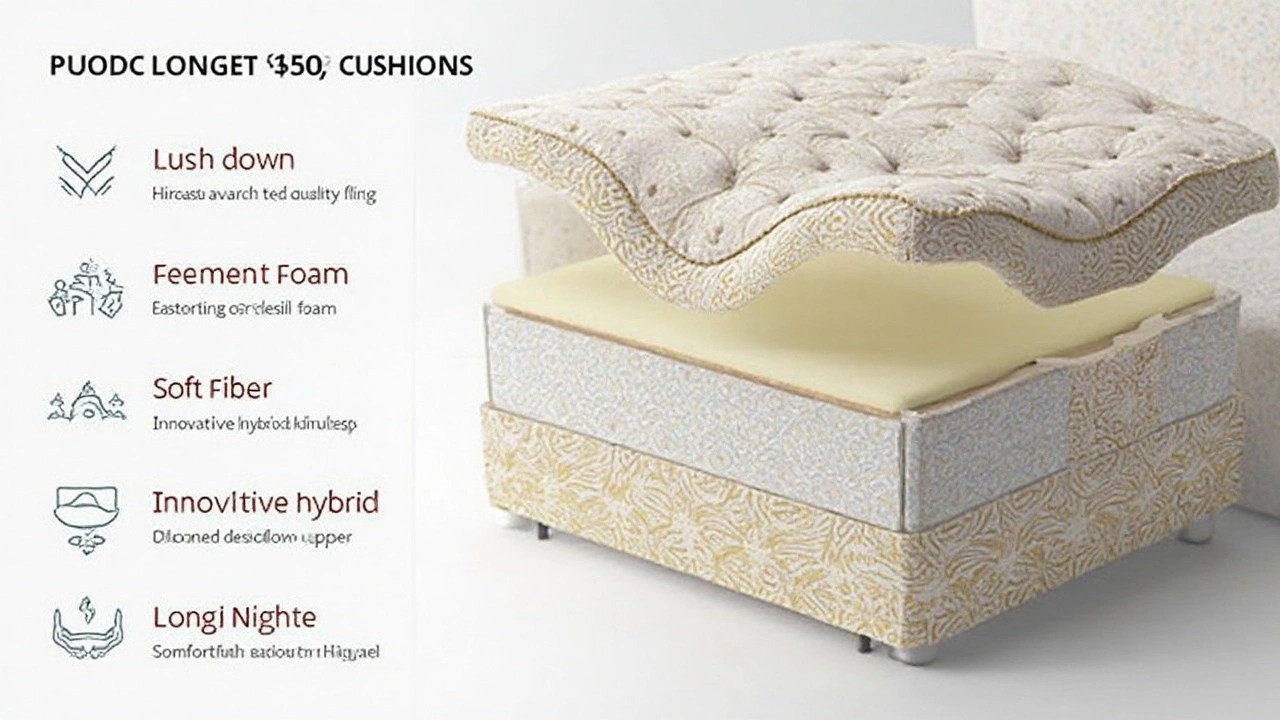If you’ve ever sunk into a sofa and thought, “Wow, this is perfect”—chances are, the seat cushion material had everything to do with it. Walk into any furniture store (or scroll online for five minutes), and you’ll see words like “high-density foam,” “down-blend,” and “poly fiber” thrown everywhere. But how do you know what they actually feel like, or what holds up after years of pizza crumbs and afternoon naps?
Let’s clear up the main materials first: you’ll mostly see foam, down (or down-blend), polyester fiber, and sometimes a mix. Each one totally changes the feel, shape, and lifespan of a cushion. Foam gives you that structured, bouncy support—great if you hate sinking in. Down cushions, stuffed with feathers, are softer and squishier, but they need a lot of fluffing, and some folks complain they smush down too much.
If you want low maintenance, polyester fiber cushions are lighter, less pricey, and hold their shape better than down, but tend to flatten out the fastest. Some savvy brands combine foam with a down or fiber layer on top, trying to get the best of both worlds: you get support from the foam, with a soft, inviting top. These hybrids are hitting the market in a big way because, honestly, most people want comfort and durability.
- Cushion Fills: What's Out There?
- How Each Material Feels (And Lasts)
- Cleaning and Maintenance: The Real Deal
- Allergy and Lifestyle Tips
- Choosing What Actually Works for You
Cushion Fills: What's Out There?
Sofa seat cushions come in a handful of main materials, each with its own fans and haters. If you want a breakdown before you even step near a showroom, here’s what you’ll actually find inside most cushions.
- Foam: The workhorse of sofa cushions. Foam comes in different densities—a high-density version is firmer and bounces back better, while low-density is squishier but gets flat faster. Most people want that balance: enough support so your backside doesn’t hit the frame, but not so hard it feels like sitting on a bench. Memory foam is popping up too, but it holds heat and some folks think it feels odd for lounging.
- Down and Feather: This is that classic, cloud-like feel—think five-star hotel sofas. Usually, you get a blend of down and feathers because pure down is pricey (and honestly, feathers add some structure). They feel amazing, but you’ll be fluffing them a lot, and they can get limp over time. Not the best if you like a tidy couch or have sniffly allergies.
- Polyester Fiber (Polyfiber): Cheaper and popular, polyfiber is light and keeps cushions feeling soft but not super supportive. If you want just a little give and hate heavy furniture, it’s an option. Downside? They flatten pretty quick, especially if the sofa is your favorite hangout spot.
- Hybrid Combos: This is where brands get clever. It’s common to see a foam core wrapped in a layer of down or fiber. You get the sturdiness of foam, but that initial softness on top when you flop down. These hybrids cost a bit more, but tons of people swear by them because it really is a “best of both worlds” thing.
Every material in seat sofa cushions does something different for comfort, shape, and how long you’ll actually love your sofa. Before picking one, think about how much maintenance you can handle, how you actually sit (or sprawl) every night, and how picky you are about sagging or lumpy cushions.
How Each Material Feels (And Lasts)
There’s a huge difference in comfort and durability depending on what’s inside your cushions. Here’s how the most common types stack up in real-life use:
- Foam: Foam is the go-to for most new sofas because it’s supportive and keeps its shape, especially if it’s labeled as “high-density.” It’s the kind of cushion that bounces back fast after you get up. Foam comes in different grades—lower density foam feels softer but flattens out in a couple of years, while high-density foam usually lasts 7 to 10 years before sagging becomes a problem. Memory foam’s trendier, but it can hold heat and some people don’t like that sinking feeling.
- Down and Down-Blend: These cushions use a mix of feathers and soft down. Sink-in comfort? Absolutely. But you have to fluff them all the time, or else they look squashed. Pure down cushions can last up to 15 years if you care for them, but most people end up with down-blend (more affordable, with foam core plus feather wrap). They’re softer but can lose their loft and sometimes poke out feathers.
- Polyester Fiber: Poly fiber cushions are soft and light. They don’t need fluffing like down, but they do compress quickly—think just two years before looking sad and flat. These are cheaper and easy to replace, but don’t count on long-term support.
- Hybrid (Foam + Topper): More high-end sofas are using layered tech. You get a foam core for support, with a thin layer of down or fiber on top for comfort. These can nail the balance—firm but cozy—and usually outlast plain fiber options by a few years.
Here’s a quick hit comparison so you can spot the pros and cons at a glance:
| Material | Feel | Longevity | Maintenance |
|---|---|---|---|
| High-Density Foam | Firm, springy | 7-10 years | Low |
| Down/Down-Blend | Soft, sink-in | 10-15 years* | High (needs fluffing) |
| Poly Fiber | Light, soft | 1-3 years | Low |
| Hybrid (Foam + Fiber/Down) | Supportive, cushy top | 5-8 years | Medium |
*Down cushions can last a long time if you’re willing to put in the care. But honestly, after 8-10 years, most start to flatten unless they’re refilled or overstuffed.
Bottom line? If lasting support is your thing, go for foam. Love that plush, sink-right-in feel and don’t mind maintenance? Down or a blend delivers—if you’re cool with regular fluffing and a few stray feathers now and then.

Cleaning and Maintenance: The Real Deal
If you’re picking new sofa cushions, you can’t ignore how easy (or annoying) they are to keep clean. The truth is, the material inside makes a huge difference in how much effort you’ll need to put in. Messy kids, pets, or just a love for snacks on the sofa? Pay close attention here.
Foam cushions are pretty chill when it comes to upkeep. If the covers are removable, you just zip them off and toss them in the wash. For spills that reach the foam, spot cleaning with mild soap and warm water usually works. Just avoid soaking the foam—mold and bad smells can show up if it doesn’t dry right. Quick tip: airing foam cushions in the sun now and then keeps them fresh.
Down or down-blend cushions are a little fussier. Feathers can trap odors and dust. While some brands use "down-proof" casings to help, that only goes so far. If you spill something wet on a down cushion, it usually means removing the fill and letting it dry out for a day or more. Otherwise, they get clumpy. Feather cushions also need regular fluffing—set a reminder on your phone if you forget, or you’ll end up with flat pancakes by the weekend.
Polyester fiber cushions score high for low maintenance. Most times, a vacuum or a shake is enough. Machine-washable slipcovers are pretty standard for these, and they don’t mind if you’re not super gentle. Just know that fibers do compact over time and may need replacing sooner than other fills.
- Sofa cushions with zippered covers are the dream—swap and wash as much as you want without calling a professional.
- For allergies, stick to synthetic fills and make sure the covers can handle hot washes.
- If pressed for time, go for stain-resistant or treated fabrics right out of the box.
Here’s a quick at-a-glance comparison for the main cleaning and maintenance points:
| Material | Spot Cleaning | Machine Washable Covers | Fluffing Needed | Dry Time (if wet) |
|---|---|---|---|---|
| Foam | Easy | Yes (if zippered) | No | 4-6 hours |
| Down/Down-blend | Tricky | Usually | Yes | 24+ hours |
| Polyester Fiber | Easy | Yes | Sometimes | 2-4 hours |
| Hybrid (Foam + Topper) | Moderate | Usually | A little | Varies |
If you want less stress and more couch time, focus on cushions with easy-care fabrics and fills. High-maintenance seats might look great in the store, but ask yourself: Do you want to be fluffing and airing out your sofa all the time, or just enjoying it?
Allergy and Lifestyle Tips
Your home’s not a museum—cushions need to work with your family’s actual life. If you or anyone under your roof has allergies, the cushion fill makes a bigger difference than most people think. Down and feather cushions can stir up sneezing and itchy eyes, especially since those tiny feathers can poke out and collect dust mites. About 10% of people are sensitive to down or feathers, and dust mites love the soft, dense insides. And let’s be honest: kids and pets only increase the chaos.
The safest bet for allergy-prone households is high-density foam or polyester fiber fill. Both are way less likely to trap dust or shed allergens. Look for cushions with tightly-woven, removable covers you can toss in the wash. Some foam cushions even come treated with anti-microbial coatings to keep things fresher, longer.
- If you go for sofa cushions with down or fiber, use allergen-proof covers—these zippered cases can seriously cut down on mess and mites.
- Lifestyle matters, too: parents and pet owners usually find foam or poly blends hold up best against spills, roughhousing, and fur. Down needs a lot more fluffing to keep from turning flat and sad after movie night.
- Quick clean tip: use a HEPA vacuum regularly to keep cushions dust-free. If you have removable covers, wash them monthly—especially during allergy season.
Here’s a quick look at how common cushion fills stack up for allergies and everyday use:
| Material | Allergy Friendliness | Best For |
|---|---|---|
| Foam | High | Allergies, heavy use, pets, kids |
| Down/Feather | Low | Adults who prefer softness, low allergies |
| Poly Fiber | Medium | Budget, easy care |
| Hybrid (Foam+Fiber/Down) | Medium | Mix of comfort and support, families |
So, if sneezing and stuffy noses are a regular thing or you want to keep sofa chaos under control, steer clear of pure down. Modern foam and poly options aren’t only easier for allergies—they’re better for real-life messes, too.

Choosing What Actually Works for You
If you’re still not sure what direction to go, it’s time to zero in on your real habits and what bugs you most about a sofa cushion. Start by thinking about who uses your sofa and how. Got little kids and pets crawling over everything? Or is your sofa a movie-night spot where comfort rules above all? Here’s a quick table with material strengths, weak points, and who gets the most out of each option:
| Material | Best For | Watch Out For | Typical Lifespan |
|---|---|---|---|
| High-Density Foam | Households needing structured support (all ages) | Can feel stiff, may break down or soften with lots of use (usually 3-6 years) | 4-8 Years |
| Down/Feather | Loungers and nap-lovers who don’t mind fluffing | Loses shape, needs daily fluffing, can trigger allergies | 5-10 Years* |
| Poly Fiber | Budget shoppers & allergy-sensitive users | Flattens out quickest, less ‘lux’ feel | 1-3 Years |
| Foam + Down Wrap | Those wanting both support and softness | Costs more, but lasts longer | 6-10 Years |
A 2023 survey from the American Home Furnishings Alliance found that 71% of people picking a new sofa said durability mattered more than the initial 'squish' factor. In other words: as tempting as a super-soft seat is in the store, it’s the cushions that keep their shape that earn their price tag over time.
If you have allergies, plain foam or poly fiber beats down every time. For folks with kids or pets, foam or foam-down hybrids tend to win, since you can vacuum them, and crumbs or hair don’t vanish inside the cushion. Miss that sink-in comfort? Go for foam wrapped with a down-blend top, but check the care label because these can be a pain to clean without removable covers.
The right pick sometimes comes down to trying out the options. If shopping in person, do the “sit test” – plop down with your usual posture and stay put for five minutes. Notice how much the cushion bounces back or sags under your weight. If you’re buying online, check reviews that talk about how the seat feels after 6 months or a year. Flattening is the usual gripe with cheap fiber fills, so if you see this in more than a couple reviews, skip that option.
- Want firmness and longevity? High-density foam is the easy bet.
- Craving softness? Down-blend, but only if you don't mind fluffing.
- Hate maintenance? Stick with foam or fiber (but watch the shape).
- Allergies? Skip down and look for hypoallergenic tags.
- Have a higher budget and picky tastes? Try a foam core with a plush wrap.
Bottom line: the best cushion material is the one you won’t regret after a year of real life. Be honest about your needs, and you’ll get a sofa seat that keeps your backside (and your bank account) happy.
